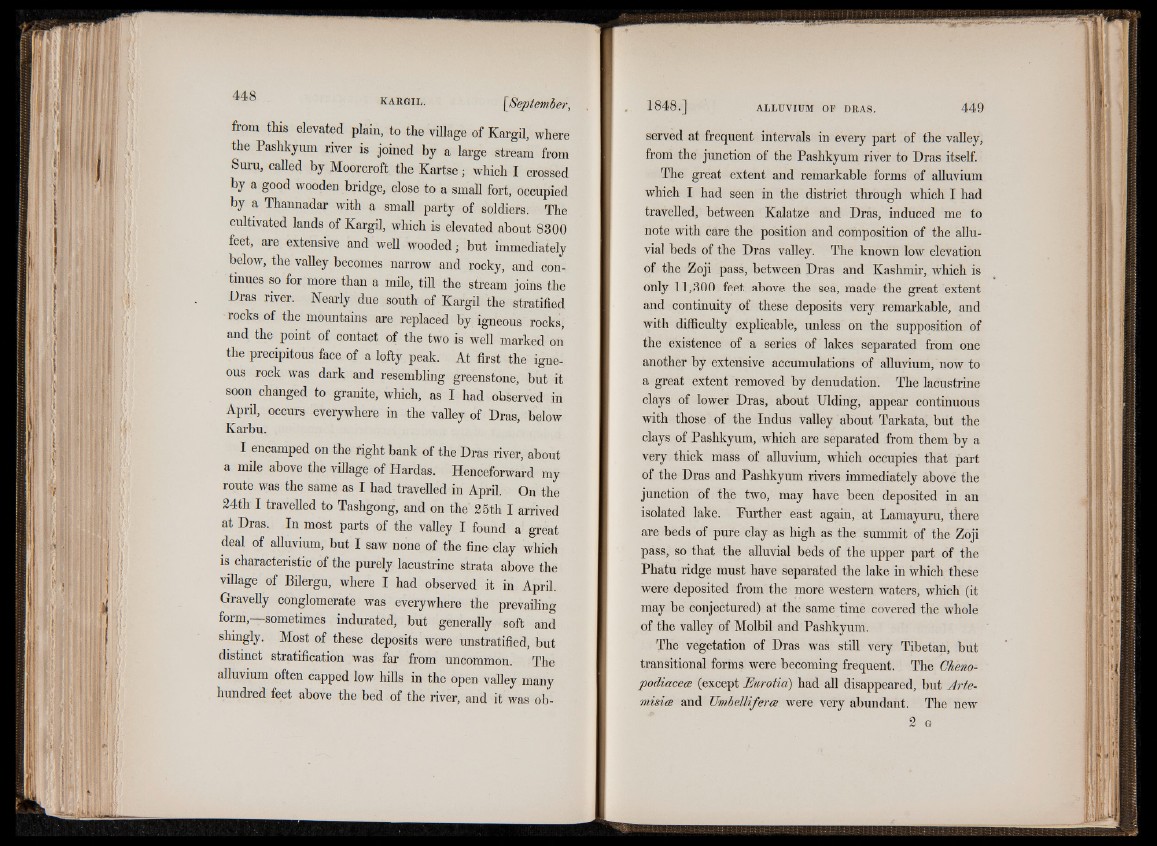
from this elevated plain, to the village of Kargil, where
the Pashkyum river is joined by a large stream from
Sura, called by Moorcroft the Kartse; which I crossed
by a good wooden bridge, close to a small fort, occupied
by a Thannadar with a small party of soldiers. The
cultivated lands of Kargil, which is elevated about 8800
feet, are extensive and well wooded; but immediately
below, the valley becomes narrow and rocky, and continues
so for more than a mile, till the stream joins the
Dras river. Nearly due south of Kargil the stratified
rocks of the mountains are replaced by igneous rocks,
and the point of contact of the two is well marked on
the precipitous face of a lofty peak. At first the igneous
rock was dark and resembling greenstone, but it
soon changed to granite, which, as I had observed in
April, occurs everywhere in the valley of Dras, below
Karbu.
I encamped on the right bank of the Dras river, about
a mile above the village of Hardas. Henceforward my
route was the same as I had travelled in April. On the
24th I travelled to Tashgong, and on the' 25th I arrived
at Dras. In most parts of the valley I found a great
deal of alluvium, but I saw none of the fine- clay which
is characteristic of the purely lacustrine strata above the
village of Bilergu, where I had observed it in April.
Gravelly conglomerate was everywhere the prevailing
form,—sometimes indurated, but generally soft and
shingly. Most of these deposits were unstratified, but
distinct stratification was far from uncommon. The
alluvium often capped low hills in the open valley many
hundred feet above the bed of the river, and it was observed
at frequent intervals in every part of the valley,
from the junction of the Pashkyum river to Dras itself.
The great extent and remarkable forms of alluvium
which I had seen in the district through which I had
travelled, between Kalatze and Dras, induced me to
note with care the position and composition of the alluvial
beds of the Dras valley. The known low elevation
of the Zoji pass, between Dras and Kashmir, which is
only 11,300 feet above the sea, made the great extent
and continuity of these deposits very remarkable, and
with difficulty explicable, unless on the supposition of
the existence of a series of lakes separated from one
another by extensive accumulations of alluvium, now to
a great extent removed by denudation. The lacustrine
clays of lower Dras, about Ulding, appear continuous
with those of the Indus valley about Tarkata, but the
clays of Pashkyum, which are separated from them by a
very thick mass of alluvium, which occupies that part
of the Dras and Pashkyum rivers immediately above the
junction of the two, may have been deposited in an
isolated lake. Further east again, at Lamayuru, there
are beds of pure clay as high as the summit of the Zoji
pass, so that the alluvial beds of the upper part of the
Phatu ridge must have separated the lake in which these
were deposited from the more western waters, which (it
may be conjectured) at the same time covered the whole
of the valley of Molbil and Pashkyum.
The vegetation of Dras was still very Tibetan, but
transitional forms were becoming frequent. The Cheno-
podiacece (except Eurotia) had all disappeared, but Artemisia
and TJmbellifera were very abundant. The new
2 G